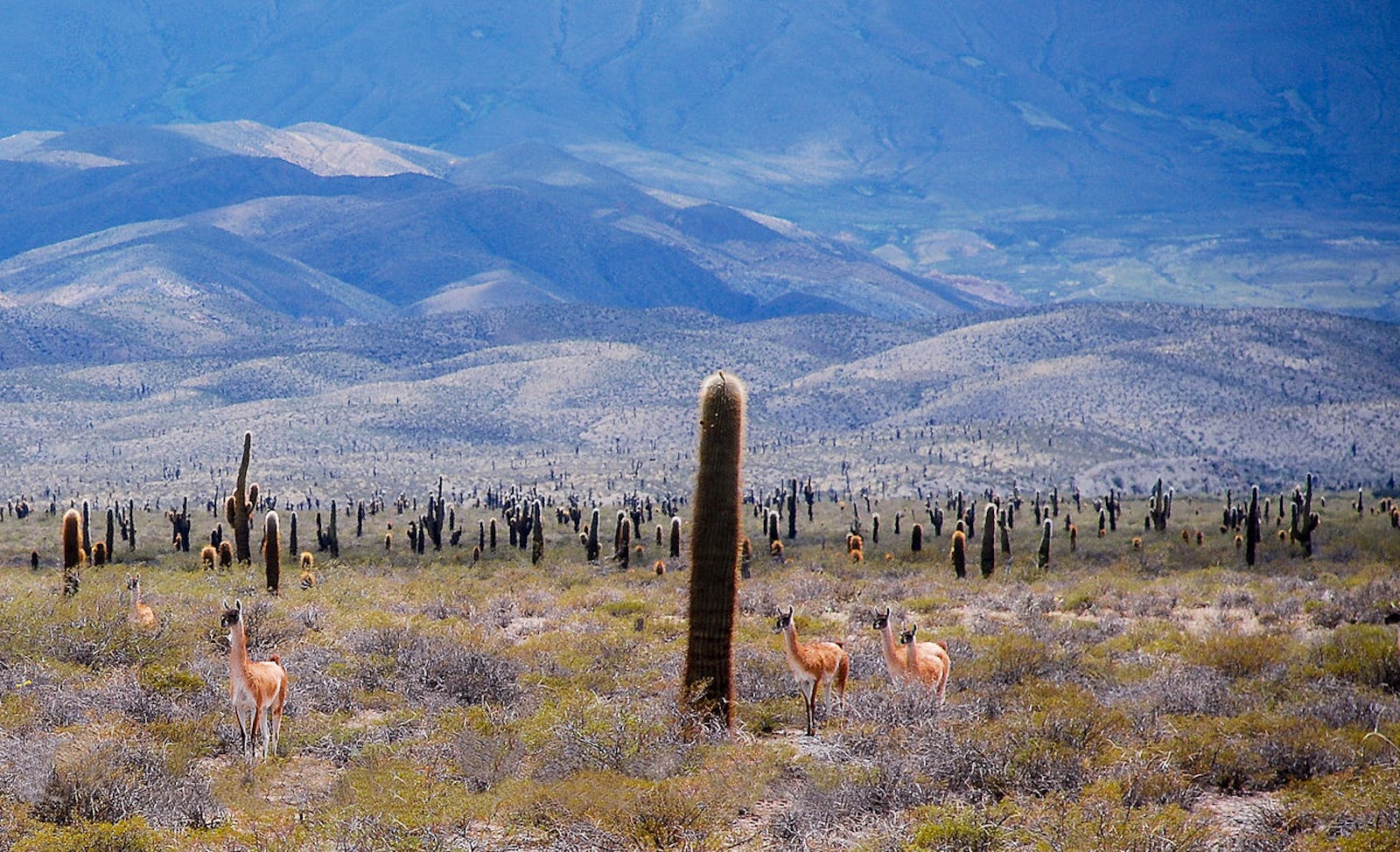High Monte
The ecoregion’s land area is provided in units of 1,000 hectares. The conservation target is the Global Safety Net (GSN1) area for the given ecoregion. The protection level indicates the percentage of the GSN goal that is currently protected on a scale of 0-10. N/A means data is not available at this time.
Bioregion: Andean Mountain Grasslands (NT5)
Realm: Southern America
Ecoregion Size (1000 ha):
11,698
Ecoregion ID:
592
Conservation Target:
53%
Protection Level:
2
States: Argentina
The Southern mountain cavy is a medium sized tailless rodent, with large eyes surrounded by a white ring and small rounded ears. It is also a very important member of the High Monte animal community; both helping to shape soil structure and move plants and seeds around. They live in large colonial burrows with up to 40 individuals sharing a complete network of tunnels and exits. These burrows help to turn over and aerate the soil.
They also collect and eat leaves, fruits, and other plant material, with mesquite being among their favorites. By bringing all that feed into the burrows they also help fertilize the soil. With so many cavies in a single burrow system, a social hierarchy in which males compete for space and resources keeps things organized.
.jpg)
The flagship species of the High Monte ecoregion is the southern mountain cavy. Image credit: Creative Commons
The High Monte ecoregion, also called the High Monte desert locally, is bounded in the west in the rain shadow of the Andes, in the north by the high arid Puna, in the east by the arid–semiarid woodlands of the Chaco and Espinal. In the south it is contiguous with the Low Monte; however it is distinct biogeographically by being at a higher elevation. The High Monte receives rains in summer while in the Low Monte it is colder, and rainfall is distributed throughout the year. The climate is temperate-arid with very little rainfall (between 100 and 450 mm annually) besides during austral summer.
The plant community and landscape in this ecoregion are often described by North Americans as resembling the Sonoran Desert, with creosote bushes, cactus and other similar elements. The animal community however is very different. The dominant vegetative formation is scrublands, that can be very open in many areas thus resembling a desert. Evergreen bushes dominated by representatives of the Zygophyllaceae family, such as species from the genera Larrea (creosote bush), Bulnesia and Plectocarpa. In addition, Montea aphyla, Bougainvillea spinosa (monte negro), and Prosopis sp. (algarrobo) can be found scattered among the bushes.
Other vegetation communities include cactus scrub, xerophilous open woodland, rock associations, psammophilous associations, and halophilous associations. Cactaceae (Trichocereus, Cereus) and Bromeliacea (Dyckia, Deuterochonia, Tillandsia) are more abundant in the northern part of this ecoregion. Endemic plants include Romorinoa girolae and Gomprhena colosacana var andersonii.
Many mammals in the High Monte are smaller, including the common desert opossum, silky mouse, the vesper mouse, the grass mouse, and the common pericote (a rodent). Larger mammals include caviomorph rodents such as the Mendocino tuco-tuco, the red vizcacha rat, the southern cavy, the common yellow-toothed cavy, the plains vizcacha, the Patagonian hare, and the exotic European hare brought by early explorers. Many of the larger mammals show convergent evolutionary mechanisms with similar dry scrub desert in North America, Australia, and Africa—meaning that different species have evolved in different areas to fill the same ecological roles.
Birds include elegant crested tinamou, cinnamon warbling finch, Darwin's nothura, and burrowing parrot. Threatened birds are peregrine falcon and Chaco eagle. Reptiles are abundant and diverse, including Argentine red tegu, false tomodon snake, Patagonian lancehead, boa constrictor, ringed hognose snake, and Chaco tortoise; amphibians are represented by the four-eyed frog, among others in this water limited habitat.
National and provincial protected areas in the ecoregion represent less than 2% of the total area, and are primarily situated in steep terrain where ranching was not historically possible. Parque Nacional Talampaya and Provincial Ischigualasto Park are two of the larger examples.
The principle threats to the ecoregion include over a century of overgrazing by goats, sheep and cattle; clear cutting for fuel; and land clearing for agriculture, mining and oil exploration. Much of the original vegetation and habitat has long since been removed, and relicts that remain tend to be in on steep terrain and otherwise hard places for people to access.
The priority conservation actions for the next decade will be to: 1) protect remaining areas where native biodiversity still thrives, including some areas in private land holdings; 2) develop financial mechanisms to fund conservation and protection of species and habitats in the region; and 3) develop new tools to cope with climate change, including new ranching techniques that reduce water use.
Citations
1. Roig F. A. Roig-Juñent S. Corbalán V.. 2009. Biogeography of the Monte Desert. Journal of Arid Environments 73:164–172.
2. WWF. Southern South America: Southern Argentina, stretching northward. https://www.worldwildlife.org/ecoregions/nt0802
3. Ojeda, R.A., Tabeni, S. and Corbalán, V., 2011. Mammals of the Monte Desert: from regional to local assemblages. Journal of Mammalogy, 92(6), pp.1236-1244.



